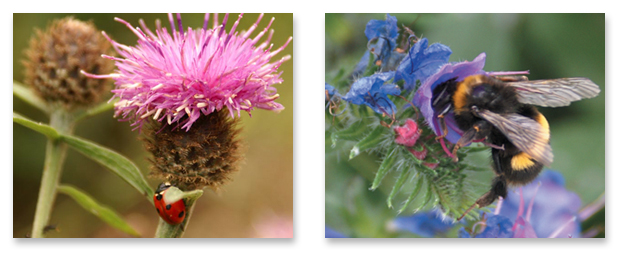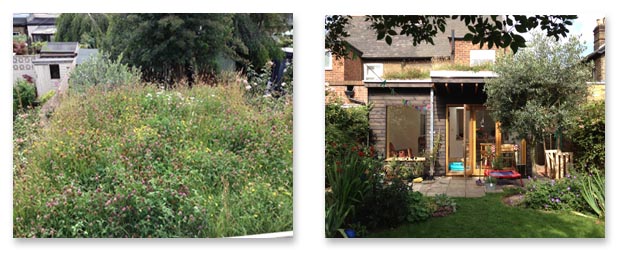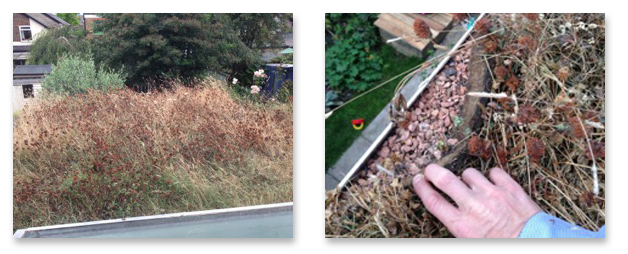If you are wondering whether installing a small wildflower meadow will make a difference to the local wildlife in your area, then the answer is most definitely yes it will. Any suitable habitat even 1m² will make a difference, and you will be amazed how quickly it will get utilised by your local fauna!
If you are limited for space in your garden then have you considered looking around for any suitable buildings or out-buildings you may have. You only need a small area to convert to a green roof and it will make a difference. It will encourage bees and butterflies and a whole host of insects.
Traditionally, the design of green roofs was angled almost entirely from an engineering perspective. Much documentation was therefore focused around the fact that green roofs are grown on a shallow substrate and require practically no irrigation or other maintenance of any kind.
More recently researchers have concentrated on the role that green roofs play in the conservation of biodiversity, especially in towns and cities, where as you would expect, natural habitats are few and far between. Although they have only produced a small body of evidence suggesting that green roofs can indeed provide living space for plants and animals, this evidence is steadily gaining momentum. The wildlife that will mainly benefit from a green roof habitat will be those species with good dispersal rates (ie the mobile species such as invertebrates and birds).

When you think of urban habitats you would be forgiven for assuming that they are often too disturbed and too degraded, to serve as a conceivable source of biodiversity. Even ecologists have been slow to recognise the potential that cities can offer as biological buffers. Green roofs may provide ecologists with a new avenue to explore. It could even be said that if suitable niches are provided on green roofs, then the plants and animals should move in rapidly, establishing communities. Research has suggested that green roofs can be taken one step further and be customised to support specific species. In these cases, they could potentially provide habitats for declining and endangered species, which would suggest that green roofs can be utilised as a species conservation tool. An exciting prospect for any ecologist!
One of our clients was kind enough to send over a few photos of his green roof showing our Wildflower Roof Turf. As you can see from the photos it is not a particularly large roof, but it adds another dimension to the garden, providing an additional habitat which also offers some species with a safe haven out of the reach of most predators. It has also been suggested that they can provide suitable nesting sites for some species of birds.

What makes this project different is the fact that the contractor didn’t go with our recommended substrate but rather a mix of 80% crushed brick with a smattering of soil. Richard Asbury commented, ‘I was concerned it wouldn’t take, especially when I saw the ‘soil’ (mainly crushed brick) but it looks great and is very healthy with lots of insects and bees.’
We wouldn’t recommend this type of substrate for our system, because it will be prone to dry out very quickly, and will more than likely in the long-term, not provide enough nutrients for the meadow turf to stay healthy. All said, the turf looked stunning for its first year. This will be due to the amount of rain we have all had to endure this year, which ironically isn’t great for wildflower meadows. However, in any normal year without biblical proportions of rain falling over the spring and summer months, it most certainly will be prone to drying out. We are working closely with Richard at the moment advising him on how best to manage his Wildflower Roof Turf for the future with regard to the substrate that he has to now work with.

What we have suggested to Richard is to cut the meadow now down to about an inch, then rake and remove the cuttings. The image on the left shows how his turf is looking now. Understandably, Richard was worried it had dried out, but all that has happened is it has prematurely gone to seed, due to the weather conditions this season. Even our roof turf on site has gone to seed early this year. This is normal and nothing to worry about.
Addressing the substrate issue however is a little more involved. He will unfortunately need to carefully lift the turf and replace the crushed brick with the correct type of soil (providing it is not high in organic matter, and hasn’t had fertiliser added to it, then it should be fine) which will support the wildflower meadow. This as you can see from the image above (right) shouldn’t damage the turf as it has not bedded into the substrate properly, due to it being mainly crushed brick! Once this has been done it will be happy to settle down for the autumn and winter months, ready to start to grow again in the spring.